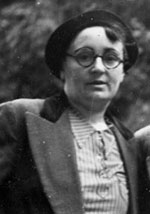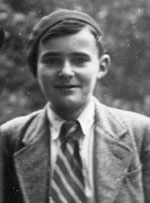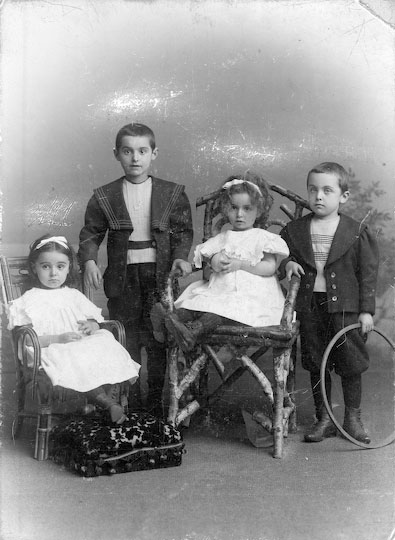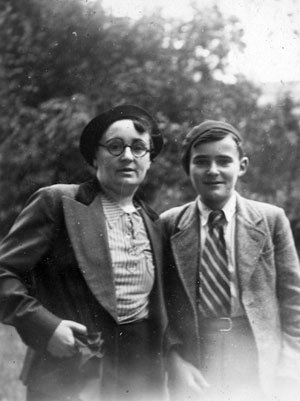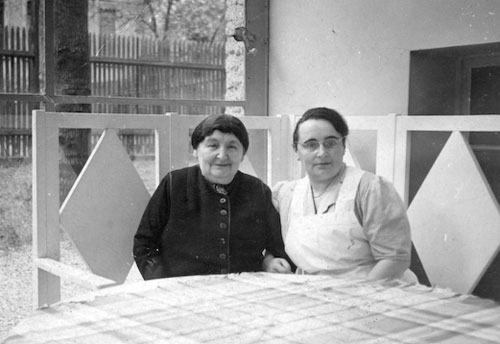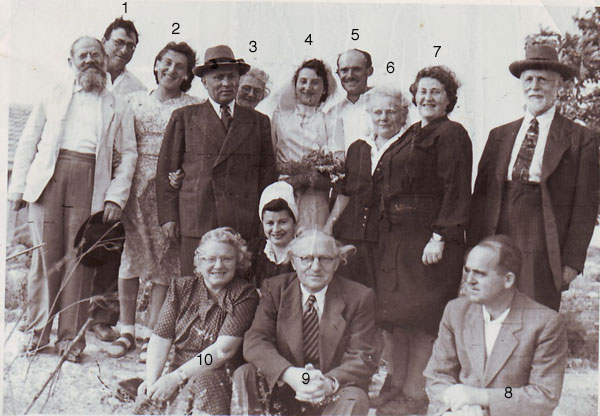Bahnhofstraße
Betty Seligmann (neé Oppenheimer)
Betty was born in Goch in 1896, the third child of Aron and Friederike (née Cohen) Oppenheimer. As did her siblings, she probably attended the Jewish school in Goch in which her father taught. On the 17 th November 1922 she married, in Goch, the salesman Mendel Seligmann who came from Cologne. Their son Joseph was born in Goch in 1925*2. During 1926 the family moved to Dinslaken, to the Duisburger Strasse 23 where they had opened a millinery shop*3. In 1927 Mendel Seligmann died in Cologne–Gnadenthal. From then on, until he was six, Joseph Seligman was raised by his grandparents in Goch. According to his own recollection, Joseph went to the Jewish orphanage in Dinslaken, when his mother moved to Leipzig in 1931. Surviving German documentation attests to his presence in the orphanage, Schlageterstrasse 43 (today Neustrasse) as of 24 th October 1933*5.
Due to conflicting records, it is not yet possible to be certain where Betty Seligmann resided between 1931-1935. Whereas Joseph's own statements, made later in life, suggest that his mother lived in Leipzig during this period, a registration card exists from Dinslaken recording her moving from there to Goch on 24 th October 1933*5. Records from Goch suggest she lived there on-and-off until 1935. That she was resident in Leipzig from at least 1935 until 1942 is proven by photographs and eye-witness statements.
In Leipzig Betty managed and ran a residential home for elderly Jewish ladies located at Auenstrasse 14 (today Hinrichsenstrasse 14) which had been established by the charity of Louise Ariowitsch. From fall/autumn 1938 her mother Friederike also resided there. The latter passed away in 1941 and was buried in Leipzig.
Betty did possess a visa which would have permitted her to emigrate to the USA, she chose however to remain with her mother and the other elderly residents. The home was also under the aegis of a USA based organisation and the building was clearly marked with the American flag.
Betty was deported on the 13th of July 1942. The destiny of the transport is still unknown. Some Publications name Auschwitz, but this is not correct. However it is possible that some of the deported people were sent to Auschwitz later. Possibly the transport went to one of the camps in the vicinity of Lublin. There are no records of surveivors of this transport. The other inhabitants of the Old peoples home in Auenstraße 16 were deported to Theresienstadt on the 19th of September 1942*10.
Joseph Seligmann From 1931/1933 to 1938 Joseph lived in the Jewish orphanage in Dinslaken, Schlageterstrasse 43 (today Neustrasse). Lessons for classes 1 through 8 were held in a large central classroom, many subjects being taught in Hebrew*6.
On the morning of 10 th November 1938, fifty Nazi men broke down the doors and stormed into the orphanage. They proceeded to destroy the entire inventory. The fearful screams of the children echoed throug the orphanage. At the time the orphanage was being run by teacher Yitzak Sophonie Herz, in the absence of the director Dr. Rothschild. He led the children into the garden – via a staircase at the back of the building. From there they witnessed the work of destruction. Thereafter a local police official decided to organise a “Parade of Jews”. This was led by two policemen and accompanied by uniformed SA men and various Nazis in civilian dress. The smaller children were placed in a cart – which was then pulled by four of the older boys. Citizens of Dinslaken, standing up to three or four rows deep lined the route of this procession to observe how the 35 orphanage children were driven through the streets to a small schoolyard close to the synagogue (the latter had just been burnt out during Kristallnacht). There they joined other members of the local Jewish congregation. All were taken into a small schoolroom and forbidden to leave it. They had to spend the whole day there without food or water. That evening they were then taken to another building the “Saalbau Rau” where they spent eight further days having to sleep on straw. The day after the orphanage was demolished – two children and Yitzak Herz managed to return there – where they buried the damaged Torah scroll of the Orphanage synagogue – as demanded by Jewish religious law. Yitzak Sophonie Herz made preparations to have the children evacuated to Belgium, via Cologne, on a children's transport organised by the Red Cross. Some of the children left the group and returned to their families. Joseph Seligmann was one of these. He is registered on 21 st November as leaving Dinslaken to go to his mother in Leipzig. It would be a short reunion, as Betty Seligmann decided that her son would be better off going to Belgium. After only one week Joseph left his mother for Cologne. He never saw her again. In the meantime Yitzak Herz had managed to take the remaining children to Cologne by truck – where they were now living in a home for Jewish apprentices. He also managed to obtain emigration permits for his charges – so it was that the children finally boarded a train in February 1939 which took them via Emmerich into the Netherlands and on into Belgium. Yitzak Herz had to leave the train before it crossed the Dutch border, leaving his charges to an uncertain future*7,8,1.
In Belgium Joseph commenced a training in horticulture & landscape gardening. Before the intended 1940 emigration of the children to Palestine, the Germans invaded and occupied the Low Countries. The children joined the columns of refugees hoping to get to France or over the Channel to the United Kingdom, but were eventually rounded up once more by Germans and put onto trucks which took them at first to Antwerp, later to Brussels. Joseph then worked on a succession of farms. In 1941 when the Germans started collecting the passports of Jews in Belgium, Joseph decided to go underground and join the resistance. He was given false papers and took part in various acts of sabotage. In the wake of the 1944 allied invasion, he joined the Dutch Royal Netherlands Brigade (Kon. Ned. Brigade Prinses Irene) and took part in combat in the Netherlands and N. Germany*1.
His knowledge of German was used immediately after the war when he interrogated German prisoners – to establish their level of involvement as Nazis. During this period he managed to visit Goch and Dinslaken. In Goch he met the Valk family whose own house had been destroyed. He organised food and clothing for them and arranged that they could live in the house of his family at Voss Strasse 42 which had remained largely undamaged*1.
After serving in the East-Indies – Joseph was discharged from the Dutch Army in 1947. He settled in Palestine. There he pursued a career in horticulture and landscaping in variuos communities over the years. From 1947 he resided in Kfar Hatoe with his wife Battia. The couple were blessed with five children and numerous grandchildren*1.
|
